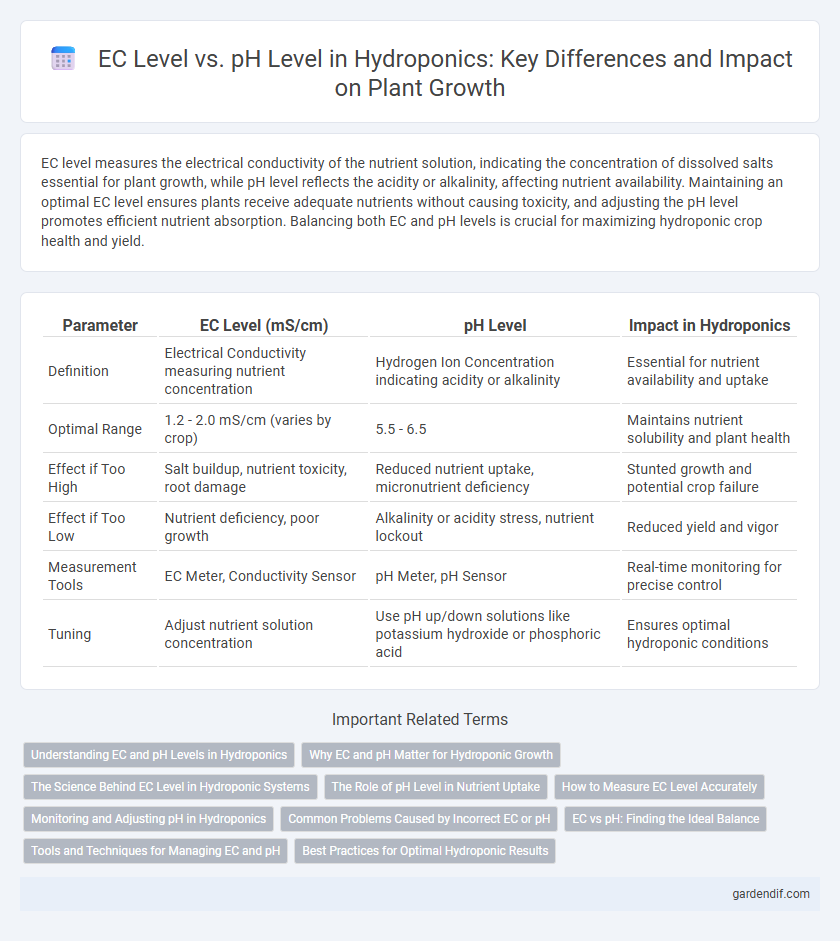
EC Level vs pH Level Illustration
EC level measures the electrical conductivity of the nutrient solution, indicating the concentration of dissolved salts essential for plant growth, while pH level reflects the acidity or alkalinity, affecting nutrient availability. Maintaining an optimal EC level ensures plants receive adequate nutrients without causing toxicity, and adjusting the pH level promotes efficient nutrient absorption. Balancing both EC and pH levels is crucial for maximizing hydroponic crop health and yield.
Table of Comparison
| Parameter | EC Level (mS/cm) | pH Level | Impact in Hydroponics |
|---|---|---|---|
| Definition | Electrical Conductivity measuring nutrient concentration | Hydrogen Ion Concentration indicating acidity or alkalinity | Essential for nutrient availability and uptake |
| Optimal Range | 1.2 - 2.0 mS/cm (varies by crop) | 5.5 - 6.5 | Maintains nutrient solubility and plant health |
| Effect if Too High | Salt buildup, nutrient toxicity, root damage | Reduced nutrient uptake, micronutrient deficiency | Stunted growth and potential crop failure |
| Effect if Too Low | Nutrient deficiency, poor growth | Alkalinity or acidity stress, nutrient lockout | Reduced yield and vigor |
| Measurement Tools | EC Meter, Conductivity Sensor | pH Meter, pH Sensor | Real-time monitoring for precise control |
| Tuning | Adjust nutrient solution concentration | Use pH up/down solutions like potassium hydroxide or phosphoric acid | Ensures optimal hydroponic conditions |
Understanding EC and pH Levels in Hydroponics
EC (Electrical Conductivity) level measures the nutrient concentration in the hydroponic solution, indicating the availability of essential minerals for plant uptake, while pH level determines the acidity or alkalinity of the nutrient solution, influencing nutrient solubility and absorption efficiency. Maintaining optimal EC levels between 1.2-2.0 mS/cm and a pH range of 5.5-6.5 ensures balanced nutrient availability and maximizes plant growth and yield. Monitoring both EC and pH levels regularly prevents nutrient lockout and promotes a healthy hydroponic environment.
Why EC and pH Matter for Hydroponic Growth
EC level indicates the concentration of nutrients available to plants in a hydroponic system, directly impacting nutrient uptake and growth rate. pH level affects nutrient solubility and bioavailability, with an optimal range of 5.5 to 6.5 ensuring maximum absorption efficiency. Maintaining balanced EC and pH levels is crucial for preventing nutrient deficiencies or toxicities, promoting healthy roots and robust plant development.
The Science Behind EC Level in Hydroponic Systems
EC level in hydroponic systems measures the electrical conductivity of the nutrient solution, reflecting the concentration of dissolved salts essential for plant growth. Maintaining an optimal EC level ensures nutrient availability without causing osmotic stress, which can harm root uptake and plant health. Unlike pH, which indicates the acidity or alkalinity affecting nutrient solubility, EC directly quantifies nutrient strength, enabling precise control over fertilizer delivery in hydroponics.
The Role of pH Level in Nutrient Uptake
pH level directly influences nutrient availability and uptake in hydroponic systems by altering the solubility of essential minerals like nitrogen, phosphorus, and potassium. Maintaining an optimal pH range of 5.5 to 6.5 ensures maximum nutrient absorption by plant roots and prevents nutrient lockout due to chemical imbalances. While EC level measures the concentration of dissolved salts indicating nutrient strength, pH controls the chemical form and accessibility of these nutrients critical for healthy plant growth.
How to Measure EC Level Accurately
Measuring EC (Electrical Conductivity) level accurately in hydroponics involves using a calibrated EC meter to assess the nutrient concentration in the solution, ensuring optimal plant growth. pH level controls nutrient availability while EC indicates the strength of the nutrient solution, so precise EC readings are crucial to avoid nutrient burn or deficiencies. Regular calibration of the EC meter using standard solutions and sampling from a well-mixed nutrient reservoir guarantees consistent and reliable measurements.
Monitoring and Adjusting pH in Hydroponics
Maintaining optimal EC (Electrical Conductivity) levels alongside precise pH monitoring is crucial for nutrient absorption in hydroponic systems. Regularly measuring pH levels between 5.5 and 6.5 ensures nutrient solubility, while adjusting with pH up or down solutions prevents deficiencies and toxicities. Continuous monitoring using digital pH meters combined with EC sensors allows growers to balance nutrient concentration and pH, maximizing plant growth and yield.
Common Problems Caused by Incorrect EC or pH
Incorrect EC (Electrical Conductivity) or pH levels in hydroponic systems can lead to nutrient imbalances, causing stunted growth, leaf burn, and reduced yield. High EC levels often result in nutrient toxicity, while low EC can cause nutrient deficiencies, both disrupting optimal plant development. pH levels outside the ideal range (typically 5.5 to 6.5) impair nutrient availability, leading to chlorosis, wilting, and root damage in hydroponic crops.
EC vs pH: Finding the Ideal Balance
Optimal hydroponic growth requires balancing EC levels, which indicate nutrient concentration, with pH levels that affect nutrient availability and absorption. Maintaining EC between 1.2 to 2.0 mS/cm and pH around 5.5 to 6.5 ensures plants receive sufficient nutrients without toxicity or deficiency. Monitoring both EC and pH allows precise control over nutrient uptake, maximizing plant health and yield.
Tools and Techniques for Managing EC and pH
Precise EC (Electrical Conductivity) and pH level monitoring is essential for optimal hydroponic growth, with digital EC meters and pH probes providing real-time data for nutrient solution adjustments. Automated dosing systems paired with sensors enable consistent regulation of nutrient concentration and acidity, minimizing manual errors and ensuring plant health. Advanced software tools integrate EC and pH data, offering predictive analytics to streamline hydroponic system management and maximize yield.
Best Practices for Optimal Hydroponic Results
Maintaining an EC level between 1.2 and 2.0 mS/cm ensures optimal nutrient availability for hydroponic crops, while pH levels should be kept within the 5.5 to 6.5 range to maximize nutrient uptake. Regular monitoring and adjusting of EC and pH with precise meters helps prevent nutrient lockout and supports vigorous plant growth. Balancing EC and pH effectively enhances root health, nutrient absorption, and overall hydroponic yield.
EC Level vs pH Level Infographic

 gardendif.com
gardendif.com